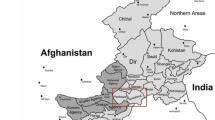Abstract
Mitochondrial DNA (mtDNA) control region (16024-576) sequences were generated from 281 individuals from South Korea. Robotic liquid handling, a redundant sequencing strategy, and a series of quality control checks were implemented to ensure the high quality of the dataset. This population sample showed a low random match probability (0.25 %) and high genetic diversity (0.9933). The haplogroup breakdown was consistent with previous studies describing Korean mtDNA variation. The 224 unique haplotypes (33 shared) presented will supplement the data already publically available.
Similar content being viewed by others
References
Kim SH, Han MS, Kim W, Kim W (2010) Y chromosome homogeneity in the Korean population. Int J Legal Med 124:653–657
Kim SH, Hong SB, Kwak KD, Lee EJ, Kim JJ, Kim KC, Jin HJ, Han MS, Kim W, Kim W (2012) Forensic genetic data of 6 Y-STR loci: an expanded Korean population database. Forensic Sci Int Genet 6:e35–e36
Brandstätter A, Peterson CT, Irwin JA, Mpoke S, Koech DK, Parson W, Parsons TJ (2004) Mitochondrial DNA control region sequences from Nairobi (Kenya): inferring phylogenetic parameters for the establishment of a forensic database. Int J Legal Med 118:294–306
Irwin JA, Saunier JL, Strouss KM, Sturk KA, Diegoli TM, Just RS, Coble MD, Parson W, Parsons TJ (2007) Development and expansion of high-quality control region databases to improve forensic mtDNA evidence interpretation. Forensic Sci Int Genet 1:154–157
Scheible M, Alenizi M, Sturk-Andreaggi K, Coble MD, Ismael S, Irwin JA (2011) Mitochondrial DNA control region variation in a Kuwaiti population sample. Forensic Sci Int Genet 5:e112–e113
Röck AW, Dur A, van Oven M, Parson W (2013) Concept for estimating mitochondrial DNA haplogroups using a maximum likelihood approach (EMMA). Forensic Sci Int Genet 7:601–609
van Oven M, Kayser M (2009) Updated comprehensive phylogenetic tree of global human mitochondrial DNA variation. Hum Mutat 30:E386–E394
Jin HJ, Tyler-Smith C, Kim W (2009) The peopling of Korea revealed by analyses of mitochondrial DNA and Y4chromosomal markers. PLoS One 4:e4210
Lee HY, Yoo JE, Park MJ, Chung U, Shin KJ (2006) Mitochondrial DNA control region sequences in Koreans: identification of useful variable sites and phylogenetic analysis for mtDNA data quality control. Int J Legal Med 120:5–14
Kong QP, Yao YG, Liu M, Shen SP, Chen C, Zhu CL, Palanichamy MG, Zhang YP (2003) Mitochondrial DNA sequence polymorphisms of five ethnic populations from northern China. Hum Genet 113:391–405
Parson W, Roewer L (2010) Publication of population data of linearly inherited DNA markers in the International Journal of Legal Medicine. Int J Legal Med 124:505–509
Poetsch M, Bajanowski T, Pfeiffer H (2012) The publication of population genetic data in the International Journal of Legal Medicine: guidelines. Int J Legal Med 126:489–490
Acknowledgments
The authors would like to thank Toni Diegoli, Elizabeth Lyons, Patricia Czarnecki, Jennifer Higginbotham, Kimberly Root, Anastasia Kondakova, Irene Liunoras, Christopher May, Anne Osborn, and Cristina Rentas (AFDIL) for data analysis and review; Walther Parson and Alexander Röck (EMPOP, University of Innsbruck, Austria) for assistance with database confirmation and haplogroup assignments; James Canik, Lanelle Chisolm, Brion Smith, COL Louis Finelli, Lt. Col. Laura Regan, Timothy McMahon, James Ross, Jon Norris, the American Registry of Pathology, and the Armed Forces Medical Examiner System for logistical, administrative, and technical support; and the National Institute of Justice (InterAgency Agreement 2005-DN-R-086) for funding.
The opinions and assertions contained herein are solely those of the authors and are not to be construed as official or as views of the US Department of Defense, its branches, the U.S. Army Medical Research and Materiel Command, the Armed Forces Medical Examiner System, the Federal Bureau of Investigation, the National Institute of Justice, or the U.S. Government.
Author information
Authors and Affiliations
Corresponding author
Electronic supplementary material
Below is the link to the electronic supplementary material.
Table S1
Mitochondrial DNA control region (16024-576) haplotypes and haplogroup assignments in a Korean population sample (n = 281). (XLSX 32 kb)
Table S2
Summary statistics are based on entire control region sequences (16024-576), and insertions at 16193, 309, 315, and 573 were ignored for all calculations. (XLSX 9 kb)
Rights and permissions
About this article
Cite this article
Scheible, M., Kim, S.H., Sturk-Andreaggi, K. et al. Mitochondrial control region variation in a Korean population sample. Int J Legal Med 128, 745–746 (2014). https://doi.org/10.1007/s00414-014-0963-7
Received:
Accepted:
Published:
Issue Date:
DOI: https://doi.org/10.1007/s00414-014-0963-7




